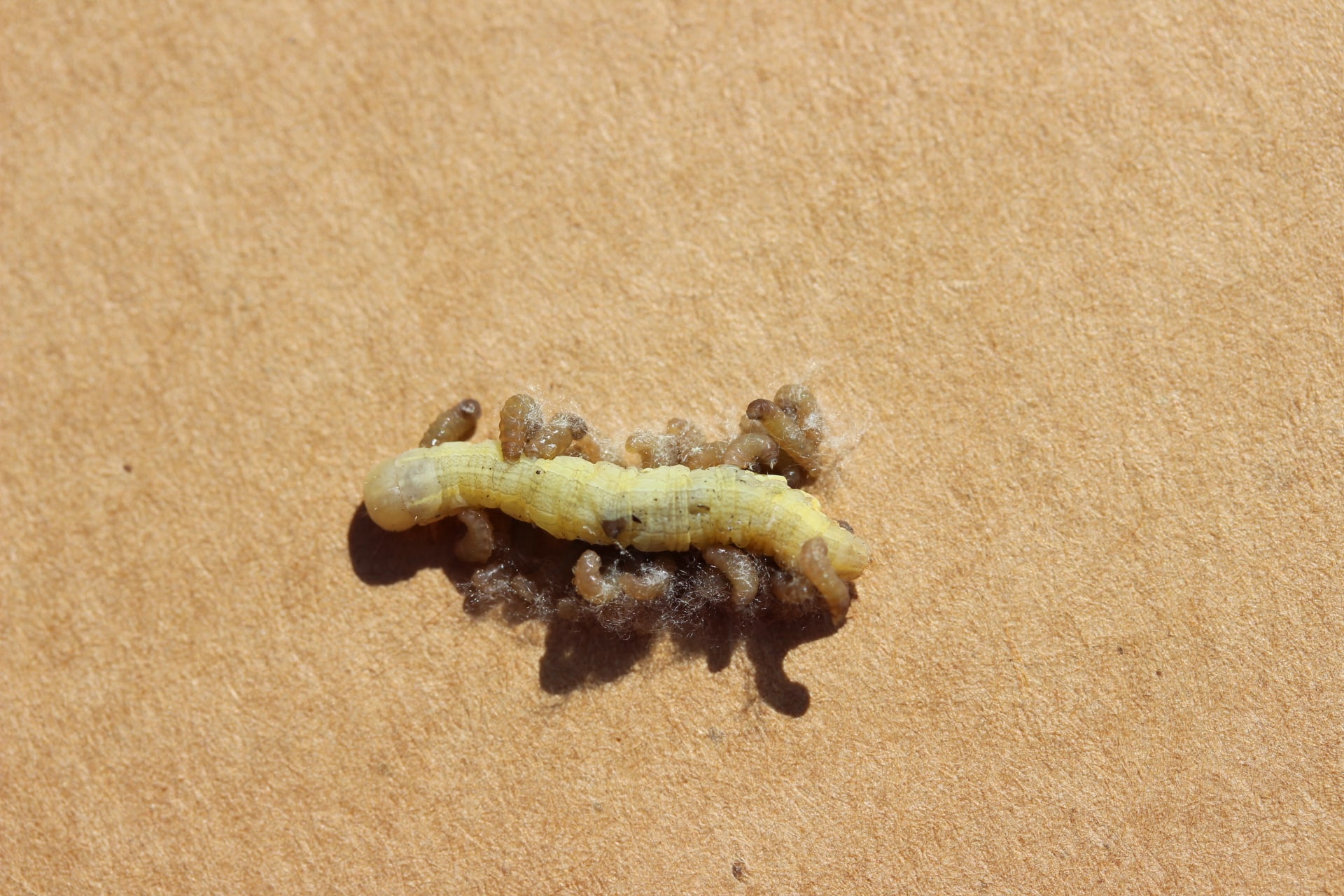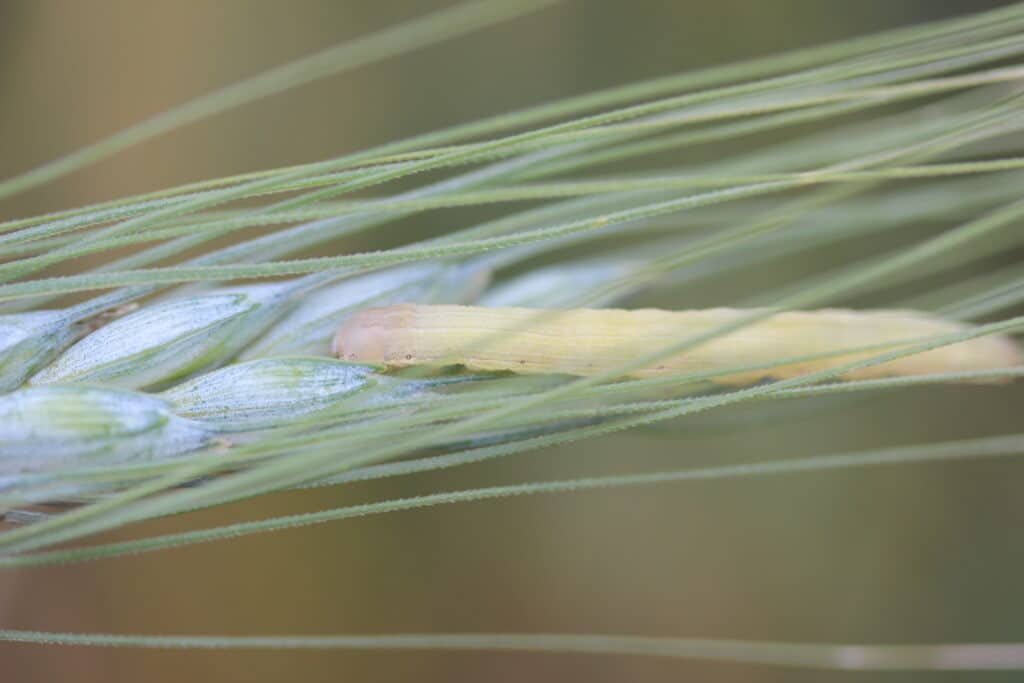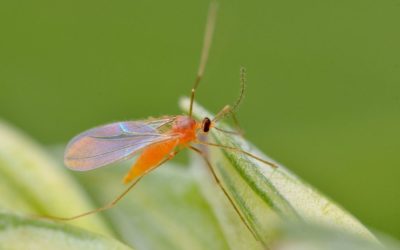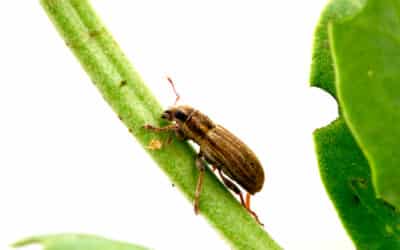The wheat head armyworm are a random threat and hard to find in Alberta fields.
An army could be invading your field at this very moment, and you might not even know it.
The wheat head armyworm is a sporadic pest that feeds on cereal grains such as wheat and barley here in Alberta and the rest of the Prairies. While its usually a minor nuisance, it can occasionally cause significant damage to the kernels of a cereal crop which can result in the crop being downgraded when it’s screened at an elevator. In fact, one wheat head armyworm can wipe out the equivalent of an entire head of wheat in a single day.
Part of the challenge for farmers when it comes to dealing with wheat head armyworms is that they can be extremely difficult to spot in a field, says Tyler Wist, a research scientist in field crop entomology for Agriculture and Agri-Food Canada (AAFC).
A member of the Noctuidae family of moths, the wheat head armyworm is typically light brown in appearance and can easily blend in with maturing wheat. If wheat isn’t yet mature, the armyworm can turn green to match the colour of the still maturing grain. To make matters worse, it usually feeds at night and spends its days on the ground where it isn’t likely to be spotted.
“Often people don’t even know they have wheat head armyworm in their fields until they go to harvest,” explains Wist, who works out of the AAFC’s Saskatoon Research and Development Centre.
Another challenge posed by wheat head armyworm is the fact that it’s highly mobile as an adult, says Scott Meers, a former entomologist for the province of Alberta who now runs his own consulting company. As a result, they can easily migrate from field to field and tend not to stick around in an area for very long.
“It’s kind of a random threat. There isn’t usually any kind of indication ahead of time that it’s going to be a problem,” adds Meers, who operates Mayland Agronomy Consulting and Crop Scouting. “We typically don’t see them very often for a second year and I don’t think I’ve ever heard of them being a problem in a particular area for three years in a row.”
Wist says that unless a farmer eyeballs wheat head armyworms in their field or on a combine they may never know they were there since the damage they cause appears very similar to the harm inflicted by grasshoppers and other insects.
Recent reports have indicated the presence of wheat head armyworms in Alberta in areas such as Beiseker, Three Hills and Drumheller. Meers says during an interview in the summer that while there was quite a bit of buzz about the pest last year, it’s too soon to say what kind of presence it’ll have in the province this year since wheat won’t start ripening in most areas until around late August. Wheat head armyworms tend to do most of their damage just prior to harvest.
So, what can farmers do to determine whether or not this insidious pest is present in their field before it’s too late? Meers says his recommendation is growers should get out and scout their fields beginning in late July. They may want to bring along a sweep net to conduct a sampling of each field to confirm the presence of wheat head armyworms.
“The only thing you can do is to get out in your field and wander through it. I know the average farmer now has 4,000 or 5,000 acres so they might have 1,000 acres of wheat… and that’s a problem,” he explains. “But there’s no substitute to getting out into your field and looking. Having said that, picking up that one field or patch, it’s still a bit of a hit or miss thing.”
The good news when it comes to wheat head armyworms is that they have been parasitized by the Cotesia genus of wasps. These wasps will lay eggs in the wheat head armyworms, which hatch about a week to 10 days later and then begin chewing their way out of the body of the armyworm to deadly effect.
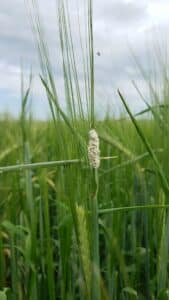
A cluster of cortesia wasps on a wheat head armyworm. Cortesia wasps lay eggs on wheat head armyworms, hatching a week to 10 days later and then chewing their way out of the wheat head armyworm body killing them. Photo: Tyler Wist
Wist says the Cotesia are sometimes referred to as field heroes because they can reduce the threat posed by wheat head armyworms. He said it’s usually easy to detect the presence of Cotesia because clusters of their white pupal cocoons will appear on the awns, or leaf blades, of a wheat plant. If there are signs of Cotesia clusters, Wist explains it’s a good bet that there are wheat head armyworms present in a field or that they were recently there.
Part of what makes it difficult to deal with wheat head armyworms is the fact that very little research has been done on them since they aren’t usually found in large populations in most parts of the Prairies, Meers says.
“When we have an occasional pest like this it’s really hard to study because you generally have no concept of where it’s going to pop up,” he explains. “It’s been kind of a frustrating thing that we can’t get better answers. It’s hard enough to get good answers for the pests we already have a good read on.”
Another challenge of dealing with wheat head armyworms is the fact that there really aren’t any established management plans do deal with them. Still, there are some chemical controls that can be used to deal with wheat head armyworms populations. Meers says a number of newer insecticides with one or two-day pre-harvest intervals such as Coragen can be effective if applied with the proper amount of lead time prior to harvest.
The challenge with using any kind of insecticides to fight wheat head armyworms is that no economic thresholds have been determined for when it’s appropriate to use them. Meers says he’s generally reluctant to recommend spraying for them unless there’s a major infestation since wheat head armyworms are parasitized and most insecticides will also eliminate those parasites and what they have to offer.
Header photo — A wheat head armyworm. Photo: Tyler Wist
Related Articles
Fusarium is Becoming the Fungus Among Us


